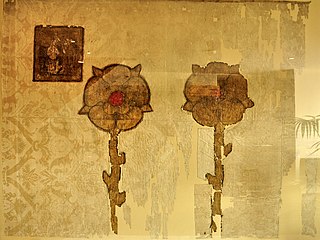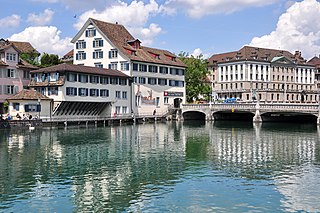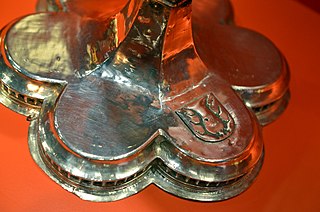
The counts of Toggenburg ruled the Toggenburg region of today's canton of St. Gallen, Switzerland, and adjacent areas during the 13th to 15th centuries.

Friedrich VII, count of Toggenburg, was the last of the Counts of Toggenburg who ruled in what would become Switzerland. His death without heirs or a will led to the Old Zürich War.

Rapperswil is a former municipality and since January 2007 part of the municipality of Rapperswil-Jona in the Wahlkreis (constituency) of See-Gaster in the canton of St. Gallen in Switzerland, located between Obersee and the main part of Lake Zurich.
The Kyburg family was a noble family of grafen (counts) in the Duchy of Swabia, a cadet line of the counts of Dillingen, who in the late 12th and early 13th centuries ruled the County of Kyburg, corresponding to much of what is now Northeastern Switzerland.

Rapperswil Castle is a castle, built in the early 13th century by the House of Rapperswil, in the formerly independent city of Rapperswil.

Rüti Monastery was a former Premonstratensian monastery, founded in 1206 and suppressed in 1525 on occasion of the Reformation in Zürich, situated in the municipality of Rüti in the canton of Zürich, Switzerland. The monastery's church was the final resting place of the Counts of Toggenburg, among them Count Friedrich VII and 13 other members of the Toggenburg family, and other noble families. Between 1206 and 1525, the monastery comprised 14 incorporated churches and the owner of extensive lands and estates at 185 localities.

Münsterhof is a town square situated in the Lindenhof quarter in the historical center of Zürich, Switzerland. It is the largest town square within the Altstadt of Zürich, and is surrounded by medieval buildings. The area forms part of the southern extension of the Quaianlagen promenades along Zürich's lakefront.

Altendorf Castle was a medieval hill castle in the municipality of Altendorf in the canton of Schwyz. On the foundation of the round castle chapel stands the choir of the chapel of St. Johann.
The following is a timeline of the history of the municipality of Zürich, Switzerland.

The Battle of Grynau in 1337 was the concluding battle in the Grynau war between the Old Swiss Confederacy and its Imperial city Zurich against a noble army under the leadership of Count Johann I (Habsburg-Laufenburg). The result was a Zurich victory.

The House of Rapperswil respectively Counts of Rapperswil ruled the upper Zürichsee and Seedamm region around Rapperswil and parts of, as of today, Swiss cantons of St. Gallen, Glarus, Zürich and Graubünden when their influence was most extensive around the 1200s until the 1290s. They acted also as Vogt of the most influential Einsiedeln Abbey in the 12th and 13th century, and at least three abbots of Einsiedeln were members of Rapperswil family.

Grimmenturm is a medieval tower and restaurant situated at Neumarkt in Zürich, Switzerland.

Elisabeth von Rapperswil was the last countess of the House of Rapperswil, and secured by her second marriage the female line of the Counts of Rapperswil and the extensive possessions of Rapperswil in the former Zürichgau to the Laufenburg line. Her son by first marriage was Reichsvogt Wernher von Homberg, and her oldest son by second marriage was Count Johann von Habsburg-Laufenburg who passed over the title of the count of Rapperswil to his oldest son Johann II and his brothers Rudolf and Gotfried.

The Grynau Castle is the name of a castle tower in the municipality of Tuggen in the canton of Schwyz, built by the House of Rapperswil in the early 13th century AD.

Oetenbach was a Dominican nunnery in the medieval municipality of Zürich in Switzerland. Oetenbach was named after the small stream of the same name at its first location at Zürichhorn, situated outside of the European Middle Ages town walls, but moved to the present Sihlbühl. The nunnery was abolished on the occasion of the Reformation in Zürich – the Waisenhaus building is its only remaining structure, now the headquarters of Stadtpolizei Zürich.

Elisabeth von Matsch was the last countess of the Swiss noble House of Toggenburg from 1436. She was the spouse of Friedrich VII, count of Toggenburg.

Johann II von Habsburg-Laufenburg was the Count of the House of Habsburg-Laufenburg and later Count of the House of Rapperswil.
The Regensberg family was a family of counts from the Canton of Zürich in Switzerland. They had possessions in the medieval Zürichgau from the probably mid-11th century and became extinct in 1331 AD. With the extinction of the male line, the city republic of Zürich laid claim to the Regensberg lands and formed the Herrschaft Regensberg respectively Äussere Vogtei.

Uster Castle is a hill castle which was built probably around 1200 AD by the House of Rapperswil in the Swiss municipality of Uster in the Canton of Zürich. Since 1995 it houses a boarding school.

Reformierte Kirche Rüti is an Evangelical Reformed church in the Swiss municipality of Rüti in the Canton of Zürich. It was built between 1214 and 1219 AD as the Romanesque style church of the then Premonstratensian Kloster Rüti, an abbey that was founded in 1206 by the House of Regensberg and suppressed in 1525 as part of the Reformation in Zürich.

















